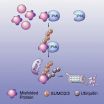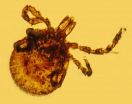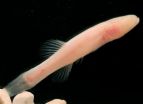Penn study shows how misfolded proteins are selected for disposal
Research has implications for understanding brain diseases caused by clumps of misshapen molecules
2014-05-29
(Press-News.org) PHILADELPHIA – It's almost axiomatic that misfolded proteins compromise how cells normally function and cause debilitating human disease, but how these proteins are detected and degraded within the body is not well understood. Neurodegenerative diseases – including Alzheimer's disease, Parkinson's disease, amyotrophic lateral sclerosis (Lou Gehrig's disease), Huntington's disease, and spinocerebellar ataxias – exact a devastating toll on aging populations throughout the world.
"Yet, there is virtually no cure for any of these diseases, and clinical trials have yielded mostly disappointing results, indicating that investigators are missing something fundamental about these diseases," says Xiaolu Yang, PhD, professor of Cancer Biology, Perelman School of Medicine at the University of Pennsylvania. All of these diseases are caused by the accumulation of toxic misfolded proteins in different types of neurons. "However, our knowledge about how cells normally remove these proteins, an issue fundamental to understanding what goes wrong in neurodegenerative diseases, is very limited."
Yang and first author Lili Guo, PhD, who was a doctoral student in the Yang lab, identified a protein recycling pathway in mammalian cells that removes misfolded proteins. Their findings appear online today in Molecular Cell ahead of the print edition. They also demonstrated this pathway's role in protecting against neurodegenerative diseases in an animal model. Guo is now a postdoctoral fellow in another Perelman School lab.
Proteins are the work horses of the cells. They are the most abundant macromolecules, extremely versatile in their functions and critically important for virtually all biological processes. However, proteins are also highly prone to misfolding due to genetic mutations, synthetic inaccuracies, and irreparable damages. What's more, the half-life of many proteins is relatively short, from a few minutes to a few hours, necessitating their continued synthesis. As such this puts a burden on the cell to maintain quality control in the correct folding of proteins.
"This paper resolves a long-standing question in protein quality control of how misfolded proteins are precisely selected for degradation," notes Yang. "This newly described system could be a valuable target for treating neurodegenerative diseases."
Two-Staged Recycling
In any normally functioning cell, two systems maintain protein quality. First, chaperone proteins, like fingers that fold paper into origami shapes, guide amino acid chains in folding into their final, proper protein forms. Second, the recycling systems dispose of misfolded proteins and ultimately breaks them up into individual amino acids. This system involves the proteasome, a protein complex found throughout the cytoplasm and nucleus of cells. "But it is unclear how misshapen proteins are recognized and shuttled to the proteasome to be degraded. This study moves the field forward because we showed that the system is common for many types of misfolded proteins," notes Yang.
In addition to identifying the step-by-step molecular players of the system that eliminates misfolded proteins, they also defined the system's method of action. The mechanism of action is a relay system with two proteins.
The first protein, PML/TRIM19, recognizes features of misfolded proteins such as exposed water-phobic inner cores, which stick out and enhance the forming of toxic protein clumps. PML selectively interacts with misfolded proteins by recognizing this and other distinct features and tags the misfolded proteins with chains of a small protein called SUMO (small ubiquitin-like modifier). The SUMO-modified misfolded proteins are then recognized by the second protein, RNF4, which tags them with chains of another small protein called ubiquitin. The ubiquitin chain is a signal that can be recognized by the barrel-shaped proteasome, leading to the degradation of misfolded proteins.
The team then went on to demonstrate the physiological importance of the elimination system using a mouse model of spinocerebellar ataxia 1 (SCA1), a fatal neurological disorder that causes problems with movement and balance. Mutations in the ATXN1 gene cause SCA1, which involves repeated segments of the DNA building blocks cytosine (C), adenine (A), and guanine (G) that appear multiple times in a row in the gene, which encodes a tract of contiguous glutamine amino acids. Normally, the CAG segment is repeated 4 to 39 times within the gene. In SCA1, the CAG segment is repeated 40 to more than 80 times, which leads to an abnormally long ataxin-1 protein that folds into the wrong 3-dimensional shape and forms clumps within the nucleus. The team showed that a PML deficiency exacerbates both the behavioral and neuropathological defects caused by the expanded CAG repeat in the SCA1 mouse, indicating that PML normally operates to protect against neurodegeneration.
The PML protein is also involved in the formation of tumors, and that's how Yang, a cancer biologist, got involved in this type of research.
"The knowledge gained from this project now provides for the possibility of new therapeutic targets for neurodegenerative diseases. Perhaps new drugs could enhance the elimination system by increasing the action of PML or RNF4, or could inhibit the inhibitors of the SUMO and ubiquitin tagging process," says Yang
INFORMATION:
Other co-authors are Alex Glavis-Bloom, Michael D. Brewer, James Shorter, Aaron D. Gitler, now at Stanford Medical Center, and Benoit I. Giasson, now at the University of Florida.
The research was supported in part by grants from the National Cancer Institute (CA088868) and the National Institute of General Medical Sciences (GM060911).
Penn Medicine is one of the world's leading academic medical centers, dedicated to the related missions of medical education, biomedical research, and excellence in patient care. Penn Medicine consists of the Raymond and Ruth Perelman School of Medicine at the University of Pennsylvania (founded in 1765 as the nation's first medical school) and the University of Pennsylvania Health System, which together form a $4.3 billion enterprise.
The Perelman School of Medicine has been ranked among the top five medical schools in the United States for the past 17 years, according to U.S. News & World Report's survey of research-oriented medical schools. The School is consistently among the nation's top recipients of funding from the National Institutes of Health, with $392 million awarded in the 2013 fiscal year.
The University of Pennsylvania Health System's patient care facilities include: The Hospital of the University of Pennsylvania -- recognized as one of the nation's top "Honor Roll" hospitals by U.S. News & World Report; Penn Presbyterian Medical Center; Chester County Hospital; Penn Wissahickon Hospice; and Pennsylvania Hospital -- the nation's first hospital, founded in 1751. Additional affiliated inpatient care facilities and services throughout the Philadelphia region include Chestnut Hill Hospital and Good Shepherd Penn Partners, a partnership between Good Shepherd Rehabilitation Network and Penn Medicine.
Penn Medicine is committed to improving lives and health through a variety of community-based programs and activities. In fiscal year 2013, Penn Medicine provided $814 million to benefit our community.
ELSE PRESS RELEASES FROM THIS DATE:
Tropical Storm Amanda gets bisected and animated by NASA's CloudSat
2014-05-29
VIDEO:
This animation shows how Cloudsat was able to get the image shown.
Click here for more information.
Tropical Storm Amanda continues to weaken in the eastern Pacific from dry air and wind shear. NASA's CloudSat satellite captured a view of the storm from the side revealing heavy precipitation when the storm was the most powerful May Eastern Pacific on record.
NASA's CloudSat satellite flew over Hurricane Amanda in the east Pacific on May 25, 2014 at 2100 UTC (5 p.m. EDT) ...
An ecological risk research agenda for synthetic biology
2014-05-29
Washington — Environmental scientists and synthetic biologists have for the first time developed a set of key research areas to study the potential ecological impacts of synthetic biology, a field that could push beyond incremental changes to create organisms that transcend common evolutionary pathways.
The Synthetic Biology Project at the Wilson Center and the Program on Emerging Technologies at the Massachusetts Institute of Technology convened the interdisciplinary group of scientists and are releasing the report, Creating a Research Agenda for the Ecological Implications ...
Engineering a better way to rebuild bone inside the body
2014-05-29
Traumatic bone injuries such as blast wounds are often so severe that the body can't effectively repair the damage on its own. To aid the recovery, clinicians inject patients with proteins called growth factors. The treatment is costly, requiring large amounts of expensive growth factors. The growth factors also disperse, creating unwanted bone formation in the area around the injury.
A new technology under development at the Georgia Institute of Technology could one day provide more efficient delivery of the bone regenerating growth factors with greater accuracy and ...
Improved identification of war wound infections promises more successful treatment
2014-05-29
War wounds that heal successfully frequently contain different microbial species from those that heal poorly, according to a paper published ahead of print in the Journal of Clinical Microbiology. These and other findings have important implications for improving wound healing, says first author Nicholas Be of Lawrence Livermore National Laboratory, Livermore, California.
The problem the researchers were addressing is that culture-based identification, which has been used to assay war wound infections, misses the many species that are difficult or impossible to culture. ...
Huge tooth fossil shows marine predator had plenty to chew on
2014-05-29
A fossilised tooth belonging to a fearsome marine predator has been recorded as the largest of its kind found in the UK, following its recent discovery.
A team of palaeontologists have verified the tooth, which was found near Chesil Beach in Dorset, as belonging to a prehistoric relative of modern crocodiles known as Dakosaurus maximus.
The tooth, which has a broken tip, is approximately 5.5 cm long.
Researchers and curators from University of Edinburgh and the Natural History Museum in London identified the item after it was bought at an online auction by a fossil ...
Amber discovery indicates Lyme disease is older than human race
2014-05-29
CORVALLIS, Ore. – Lyme disease is a stealthy, often misdiagnosed disease that was only recognized about 40 years ago, but new discoveries of ticks fossilized in amber show that the bacteria which cause it may have been lurking around for 15 million years – long before any humans walked on Earth.
The findings were made by researchers from Oregon State University, who studied 15-20 million-year-old amber from the Dominican Republic that offer the oldest fossil evidence ever found of Borrelia, a type of spirochete-like bacteria that to this day causes Lyme disease. They ...
Remember parathyroid hormone as well as vitamin D to assess vitamin's role in diabetes
2014-05-29
TORONTO -- Combined assessment of parathyroid hormone along with vitamin D may be needed to assess the impact of vitamin D status on sugar metabolism, according to Toronto researchers. Their study is published on-line in Diabetes on May 29 2014.
The new findings might explain why studies of vitamin D alone have been conflicting and why clinical trials of vitamin D supplementation to improve diabetes have been disappointing, says principal investigator Dr. Ravi Retnakaran. He is a clinician-scientist at the Lunenfeld-Tanenbaum Research Institute at Mount Sinai Hospital ...
Grape-enriched diet supports eye health
2014-05-29
FRESNO, CA – New research presented this week at the Association for Research in Vision and Ophthalmology conference in Orlando, Florida suggests that regular grape consumption may play a role in eye health by protecting the retina from deterioration. Specifically, a grape-enriched diet resulted in a protective effect on retinal structure and function.
The retina is the part of the eye that contains the cells that respond to light, known as photoreceptors. There are two types of photoreceptors: rods and cones. Retinal degenerative diseases affect over 5 million people ...
First-of-its-kind study: Swimmers gain an advantage when they recover with chocolate milk
2014-05-29
Grabbing chocolate milk after a hard swim could give swimmers a performance edge, according to new research presented at one of the nation's top sports medicine conferences – the American College of Sports Medicine's annual conference.1 In a sport where seconds and even tenths of a second can make a big difference and intense practice routines are the norm, Indiana University researchers found that when collegiate, trained swimmers recovered with chocolate milk after an exhaustive swim, they swam faster in time trials later that same day. On average, they shaved off 2.1 ...
The Hoosier Cavefish, a new and endangered species from the caves of southern Indiana
2014-05-29
A new eyeless cavefish is described from Indiana and named after the Indiana Hoosiers. It is the first new cavefish species described from the U.S. in 40 years. Notably, it has an anus right behind its head, and the females brood their young in their gill chamber. The new species was described in the open access journal ZooKeys.
The new species, Amblyopsis hoosieri, is the closest relative of a species (A. spelaea) from the longest cave system in the world, Mammoth Cave in Kentucky. These two species are separated by the Ohio River, which also separates the states of ...
LAST 30 PRESS RELEASES:
Why nail-biting, procrastination and other self-sabotaging behaviors are rooted in survival instincts
Regional variations in mechanical properties of porcine leptomeninges
Artificial empathy in therapy and healthcare: advancements in interpersonal interaction technologies
Why some brains switch gears more efficiently than others
UVA’s Jundong Li wins ICDM’S 2025 Tao Li Award for data mining, machine learning
UVA’s low-power, high-performance computer power player Mircea Stan earns National Academy of Inventors fellowship
Not playing by the rules: USU researcher explores filamentous algae dynamics in rivers
Do our body clocks influence our risk of dementia?
Anthropologists offer new evidence of bipedalism in long-debated fossil discovery
Safer receipt paper from wood
Dosage-sensitive genes suggest no whole-genome duplications in ancestral angiosperm
First ancient human herpesvirus genomes document their deep history with humans
Why Some Bacteria Survive Antibiotics and How to Stop Them - New study reveals that bacteria can survive antibiotic treatment through two fundamentally different “shutdown modes”
UCLA study links scar healing to dangerous placenta condition
CHANGE-seq-BE finds off-target changes in the genome from base editors
The Journal of Nuclear Medicine Ahead-of-Print Tip Sheet: January 2, 2026
Delayed or absent first dose of measles, mumps, and rubella vaccination
Trends in US preterm birth rates by household income and race and ethnicity
Study identifies potential biomarker linked to progression and brain inflammation in multiple sclerosis
Many mothers in Norway do not show up for postnatal check-ups
Researchers want to find out why quick clay is so unstable
Superradiant spins show teamwork at the quantum scale
Cleveland Clinic Research links tumor bacteria to immunotherapy resistance in head and neck cancer
First Editorial of 2026: Resisting AI slop
Joint ground- and space-based observations reveal Saturn-mass rogue planet
Inheritable genetic variant offers protection against blood cancer risk and progression
Pigs settled Pacific islands alongside early human voyagers
A Coral reef’s daily pulse reshapes microbes in surrounding waters
EAST Tokamak experiments exceed plasma density limit, offering new approach to fusion ignition
Groundbreaking discovery reveals Africa’s oldest cremation pyre and complex ritual practices
[Press-News.org] Penn study shows how misfolded proteins are selected for disposalResearch has implications for understanding brain diseases caused by clumps of misshapen molecules





